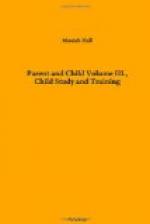All that training and education can do is to inhibit under ordinary conditions certain undesirable tendencies and instincts and to strengthen through exercise those that are desirable; and even then when a crisis comes, the old, hereditary instinct is apt to break through its thin veneer and actually frighten the individual at the unexpected strength it reveals. Slap any man in the face and see what chance his life-long education has against the old barbarous instinct for fighting. But notwithstanding the strength and tenacity of instincts, training and education may inhibit some of them and so transform others into useful habits that for most purposes in life their subjugation seems complete.
A tremendous, almost divine power rests, therefore, in the hands of parents—the power to mold and fashion and transform the impulses and instincts of their children into whatsoever ideals of life and conduct they themselves possess. Where is the parent who fully realizes his privilege and completely performs his sacred duty?
LESSON VII
QUESTIONS ON THE TEXT
1. What are the supreme needs of the infant?
2. What is the first mental fact to note?
3. Illustrate reflex movement, instinctive movement, impulsive movement.
4. Contrast the impulses of children with the instincts of lower animals.
5. What opportunity is given parents through the impulsive movements of the infant?
6. What only may training and education hope to accomplish with the instincts of children?
7. What almost divine power is possessed by parents in the training of children?
8. Quote from the Doctrine & Covenants also a passage that deals with the responsibility of parents in teaching the gospel to their children.
Reference: For a further study of instincts, selections from “Fundamentals of Child Study,” by Kirkpatrick, will be found helpful. Also chapters from “Elementary Psychology,” by Phillips.
HABIT
Habit Is the Tendency to Make Certain Actions Automatic. It Is a Great Time Saver, and Forms the Basis for Training and the Acquirement of Skill
Once activity starts in any direction, the tendency is to persist until satisfaction is reached. If the movement results in pain or even discomfort, or if the end reached is not satisfactory, the movement will be inhibited or discontinued and probably will not be attempted the second time. Whenever the end reached does give satisfaction, the activity is sure to be repeated, and in these later attempts, efforts will be made to reach the end more quickly and with less effort. This is done through eliminating the unnecessary movements and combining the right ones until the complete process is performed with ease and skill.




